WHAT'S UP THERE
observations of new atmospheric electrical phenomena
A BRIEF HISTORY ON THE DISCOVERY OF SPRITES, JETS, AND ELVES
AND HOW TO OBSERVE THESE TYPE PHENOMENA
FROM YOUR OWN OBSERVING LOCATION
Otha H. Vaughan,Jr. NASA/MSFC
and
Walter A. Lyons, FMA
Storm chasing with respect to tornados is quite the vogue
these days,wears out one's car, burns up gasoline, and taxes the
nerves of even the hardiest of the twister trackers.But there
are other mysterious, thunderstorm-related phenomena that now
can be viewed above distant thunderheads in he peace and tranquillity
of a spring or summer night while observing the night sky from
your location. Less than ten years ago, nobody had heard of sprites,
blue jets and elves, in fact, the terms hadn't even entered the
meteorological vocabulary. Recent research, however, has now confirmed
that the observations, during the past century, by pilots and/or
ground observers, who reported an entire menagerie of strange,
luminous, lightning-related flashes dancing high above thunderstorm
tops were occuring, can now be taken seriously. And you can, if
you know how, observe some of these interesting phenomena with
the naked eye. Here's a brief history of how sprites, jets, and
elves were discovered using low light level TV cameras observing
from the ground, aircraft, and space and how you might be able
to spot some on your own.
In decades past, the textbooks said weather stopped at the tropopause,
the layer separating the turbulent troposphere from the quiescent
stratosphere above. Not so. As long ago as 1886, people were publishing
reports in which they struggled to describe momentary discharges
of "lightning," that they had observed to shoot upward
and terminate high above storm clouds.
A 1903 paper by W.H. Everett discussed his observation
"rocket lightning ... a luminous tail ...shooting straight
up ... rather faster than a rocket... "
An from Africa in 1937 came reports of D. Malan
"long and weak streamers of reddish hue...some 50 kilometers
high..."
English and American scientific papers from the 1950s detailed
what seemed to be flames appearing to shoot above thunderstorms
seen near the horizon. Radar studies by G.C.Rumi of Cornell University
in 1957 also reported that echos were being recieved from high
in the stratosphere above thunderstorms that appeared to be from
some form of lightning. Recently Earle Williams of the Massachusetts
Institute of Technology took a closer look at a nighttime photograph
of an Australian thunderstorm in his possession since the late-1980s
which showed a lightning channel extending into the clear air
above the storm top in turn appears to have "blue flame"
fanning upward, perhaps even into the stratosphere. Pilots, both
civilian and military, reported that they have seen at night faint
plumes of light
"extending from the top of the thunderhead
from a pool of light from the lightning discharge ..."
Many of these observations were published in books of meteorological
esoterica alongside reports of turtles encased in hailstones,
half meter wide snow flakes and showers of toads, chunks of ice,
fish, seeds and whatnot. Interesting,but what could be the relevance
of such events variously termed "upward lightning",
"cloud-to-stratosphere lightning", "rocket lightning",
or"cloud-to-space" lightning?
One clue was offered,as early as 1920 and then again in 1956,
by Nobel Prize winning British physicist C.T.R. Wilson, the inventor
of the Wilson Cloud Chamber, who saw
"diffuse fan-shaped
flashes of greenish color extending upward into the clear sky..."
.
He speculated then than such discharges between cloud tops and
the ionosphere might be a normal accompaniment of lightning discharges
to earth, but ones which are visible only under very special conditions.
These might represent a heretofore unknown component of the global
electrical circuit.
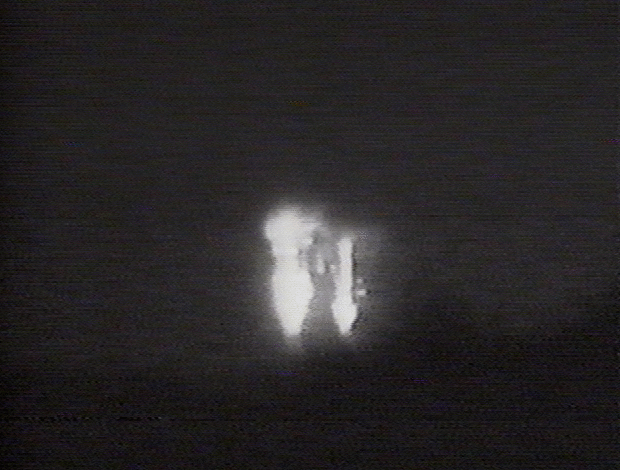
Credit: Dr J.R. Winkler July 6th 1989
With the hard evidence now in hand, the race was on in mainstream scientific circles to find out what was going on way up there.
Lightning researchers, Otha H. Vaughan, Jr. and Richard Blakeslee from the NASA Marshall Space Flight Center (MSFC ), Bernard Vonnegut, State University of New York at Albany (SUNY at Albany, and Marx Brook of New Mexico Inst. of Mining and Technology ( NMIT ) to at Socorro, N.M. began in 1986 to conduct from the Space Shuttle the Mesoscale Lightning Observational Experiment (MLE), to observe the earth's mesoscale thunderstorm complexs and to determine their flash rate and size of the lightning flashes being created by these systems with it's main purpose for providing design criteria for use in developing a future lightning detection and location satellite that would be placed in orbit during the 90's. During our observational program in October 1989 we observed strange 'upward lightning'like events or bolts of "rocket like lightning" in our video recordings of thunderstorms while using the low light level TV cameras of the Space Shuttle as the Shuttle was moving across Northwestern Australlia. The flashes were observed by payload bay Silicon Intensified (SIT) Vidicon cameras as they were observing,
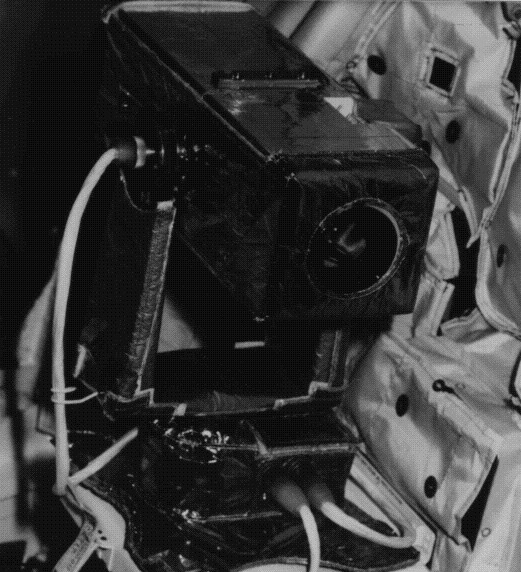
at night, those thunderstorms that were located near the limb
of the earth. The earth was being illuminated under very low moonlight
conditions ( ie near new moon illumination ) thus enhancing the
effective constrast ratio of the event against the earth's illumination.
The evidence suggested that these flashes which did not look like
the normal lightninmg must be occuring above the anvils of very
active thunderstorm complexes which could not be seen in the video.
Here's a few of the sprites that we have seen from the Space Shuttle
as it orbits the earth. It is possible that we may see this type
or similiar phenomena on other planets in the future as we fly
by an observe these planets with low light level TV cameras and
other sensors.
At FMA'S rural laboratory, the Yucca Ridge Field Station,
situated near Fort Collins on the High Plains east of the Colorado
Front Range, Dr. Walter A. Lyons and his associates, while conducting
an lightning observational research program under a KSC Small
Business Inovative Research (SBIR) NASA SBIR-92-1 contract that
started in 1992 and was extended into 1993, waited during the
summer nights of 1993 for the right conditions to be able to observe
big thunderstorm clusters that were far enough away so they could
easily be seen in the stratosphere and mesosphere region above
their anvil canopies. This contract stated a research requirement
"for a better understanding of risk, a characterization of
upward travling discharges from the tops of electrified clouds
and the frequency of occurance is needed ". The research
goal was to try to determine if the upward appearing lightning
might in some way present a hazzard to the Space Shuttle, if during
a part of it's re-entry phase, enters the atmosphere and flys
over an active large mesoscale convective storm system as well
as to learn more about this newly observed phenomena.
On the night of 7 July 1993, giant thunderstorms were boiling over Kansas and Nebraska, one of the series of mesoscale convective complexes that drowned the midwest in record setting flooding rains far to the east.They aimed a low-light video camera, cousin to the night scopes used by the military,to the east and began taping. For the first two hours, not much happened, except for the almost continuous flashing of lightning within the distant clouds. Then, suddenly, a bright flash occurred high above the storm tops (appearing white on the monochrome television system screen). Over the next several hours, over 240 high altitude flashes were captured.
Here'a What a typical sprite looks like in from Dr. Lyons observational site.
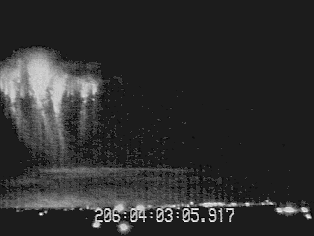
The very next night, University of Alaska scientists, working
under NASA HDQS and NSF funding , obtained similar images from
a high-flying NASA DC-8 research aircraft over Iowa. Since then,
thousands of flashes have been recorded using low-light video
from the ground and from air. While easily visible on the television
monitor on that very first night in Colorado, Dr. Lyons was unable
to see anything with the naked eye while staring above the distant
clouds. But several nights later, when the show started again,
with some patience, and dark adapted eyes, there they were, he
saw the bright reddish curtains dancing a gossamer ballet high
above the distant storm clouds.
In 1994, while flying an extremely sensitive color camera normally
used for auroral photography in a high altitude aircraft, the
University of Alaska scientists confirmed that the flashes indeed
have a generally reddish color, but which often fades to purple
or blue in the downward extending tendrils.
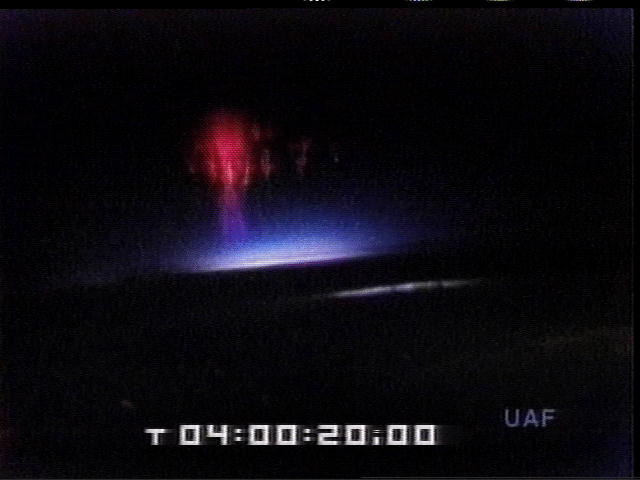
These type flashes were named "Sprites" by Dr. Davis
Sentman of UAF, which incidently are the creatures in Shakespeare's
"The Tempest," in part because of their transient, ephemeral
nature. But unlike the bard's characters, these sprites are very
real indeed.
And the sprites were soon found to have company. At least
two other distinct phenomena have been discovered to date. While
flying near an especially active hailstorm in Arkansas, the University
of Alaska team were startled to see blue beams of light shooting
upward directly out of cloud tops at speeds over 100 kilometers
a second.
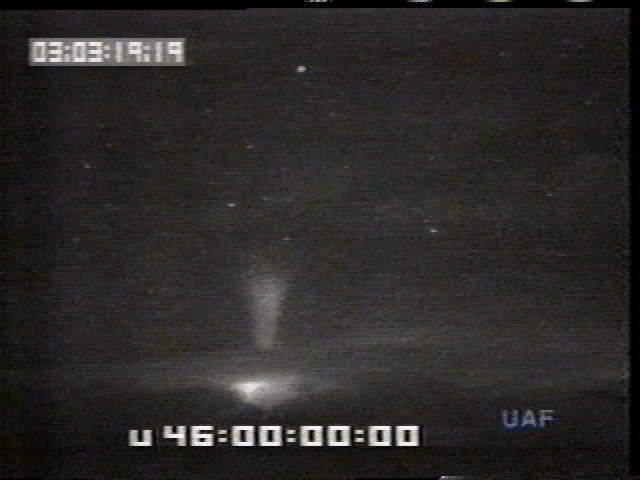
They reach heights of 40 or 50 kilometers (two or three times
the cloud heights) before fading away. Around 52 of these "blue
jets" were seen that night during a 22 minute time interval.
The Blue jets seems to be a very rare occurance at the present
time since we have seen them only associated with one storm. The
discovery of the blue jet appears to explain many of the strange
reports over the last century that did not seem to jibe with the
characteristics of the red sprites. It appears that the blue jet
can be seen with the naked eye as reported by the pilots if you
are lucky enough to be around on a dark night when that rare storm
produces them. Based only on a few sparse reports, intense hailstorms
may be the best candidates for the production of the blue jets
but their origin is still unknown.
Before the discovery of the red sprites and blue jets there was
an observation in 1990 of a flash in the airglow which was also
observed using the Shuttle's low light level TV cameras as the
shuttle was passing over French Guiana, South America and the
cameras were looking, to the northeast with the coastline an Atlantic
ocean in the field of view, at a thunderstorm in the distance
rather that looking directly down to the earth as the cameras
are usually used while conducting the MLE observational program.
Dr.Bill Boeck, a NASA Summer Faculty Research Felow, who was working
here at NASA MSFC,called it "Flash in the Air Glow"at
that time. This type event can now be described as an Emissions
of Light and VLF Perbations from EMP sources (ELVES) which were
later recorded by others on video. In 1995 scientists from the
University of Tohoku (Japan) and Stanford University, working
with other science teams at the Yucca Ridge Field Station confirmed
the presence of this phenomena and called it ELVES. These emissions
were actually predicted by theorists before they were ever caught
on tape. The elves appear as giant expanding disks of light between
70 and 100 kilometers altitude. They are caused by the passage
through the ionosphere of the electromagnetic pulse (EMP), the
intense radio waves emitted from powerful lightning flashes. Though
huge, sometimes expanding to more than 400 kilometers in diameter,
the elves are so transient (less than one-thousandth of a second),
it is unlikely the human eye could detect them.
Here's a sample of a sequence of high speed video of what
an ELF looks like as seen from a ground observing site located
at the New Mexico Institite of Mining and Technology (NMIT) Langumire
Laboratory, at Socorro, NM.
But the red sprites can be seen by the naked eye. They are
by far the most common of these mesospheric creatures, and now
we know where they "live". So a plan for some serious
"sprite hunting" is relatively easy to develop.
Sprites come in a bewildering variety of sizes and shapes.They
can look like giant red blobs, picket fences, upward branching
carrots, or tentacled octopi. The sprite luminosity can extend
upward as high as 95 km, with the brightest part usually located
between 50 and 75 km altitude. The often bluish tendrils can sometimes
extend downward below 30 km, close to, but probably not touching,
the cloud tops. Sprites can occur singly or in clusters which
sometimes fan out for over 150 kilometers. Sprites appear to be
uniquely associated with cloud-to-ground (CG) flashes of positive
polarity, usually those having peak currents larger than most
of the other positive CG events in the storm. By comparison to
the pencil- thin channel of their parent positive CG flash, the
volume illuminated by a large sprite can reach hundreds or even
thousands of cubic kilometers.
So now that we know about all the 'electrical action' above the
clouds, a natural question is - can we see and photograph them?
The answer is yes...and no. Taking standard photographs will not
work unless you have a film with an ISO of 2 million (don't bother
to ask for it in the photo store). To take images, you need a
low-light video system. This is well within the reach of well
funded scientific investigators, but not your a verage storm watcher.
Yet under ideal viewing conditions you can indeed see sprites
with the naked eye. Here's how.
REFER TO THE FOLLOWING IMAGE WHILE READING.
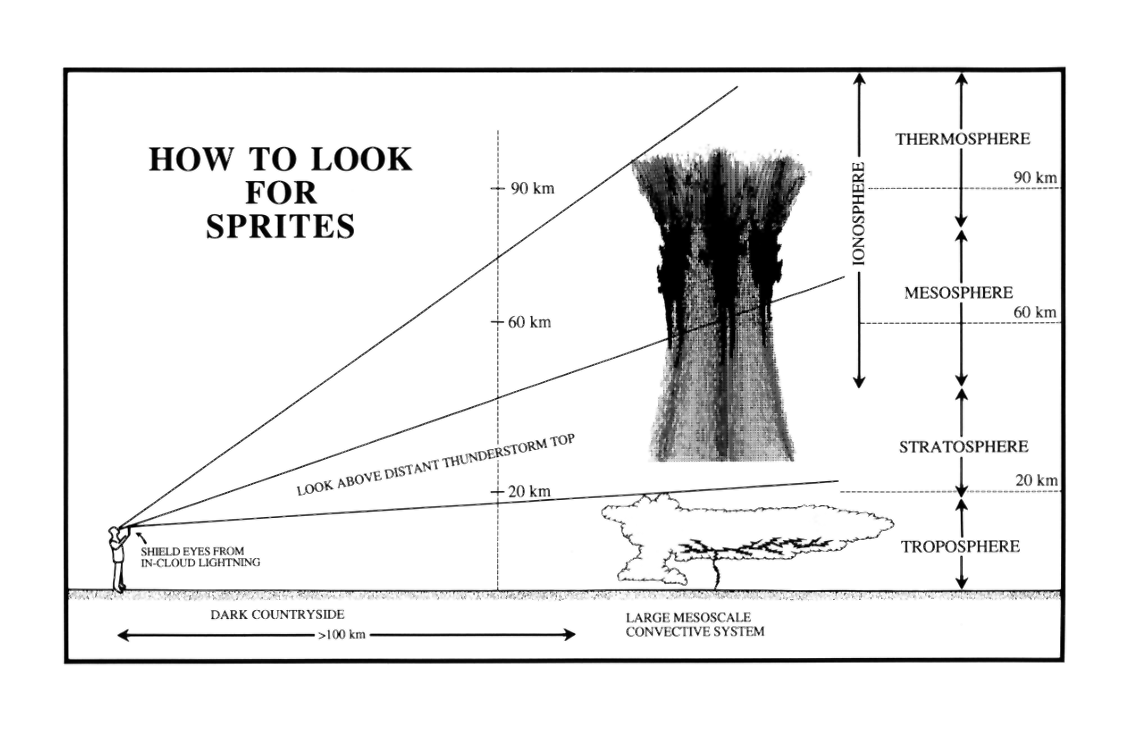
Sprites occur high above very large thunderstorm systems.
Since they are so high up, it is much easier to see them if they
are at least 50 to 100 kilometers away. Sprites have been visually
detected as far as 400 km out, but those occurrences are rare.
Not every thunderstorm produces s prites, even if it has vigorous
lightning. To improve your chances, check out the radar echoes
on your local TV or the Weather Channel. Look for thunderstorm
clusters that combined are at least 150 kilometers on a side.
If you have access to data from the National Lighting Detection
Network, look above the part of big storms where the positive
CGs are occurring. This is most often in the large stratiform
or anvil region of storm systems.
To actually view the sprites, find a location with a good
view of the horizon. The further away from the city lights, the
better. It is best to choose a dark night with no moonlight. In
the eastern and southern United States, unfortunately, haze and
air pollution can sometimes blot out the sprites. Let your eyes
adapt to the dark for at least ten minutes. Look in the direction
of the big storms. If you can see the illuminated tops of the
distant storms, shield your eyes (a piece of cardboard can help)
from the lightning flashing within the clouds. Concentrate your
gaze at an altitude about four to five times the height of the
cloud top, not the storm itself. Then be patient. In the more
active storms, sprites can occur every one or two minutes, but
every five to ten minutes is more common. They only last from
one one-hundredth to one-tenth of a second. Blink and you can
miss one. Due to a quirk in human night vision, you are often
more likely to perceive them out of the corner of your eye. What
will you see? To many it looks like the aurora borealis turning
on and off in an instant. The true sprite color is salmon red,
but at such low light levels the eye can play tricks on you and
you might perceive them as green, orange or white. If you are
looking in the right place and think you saw something, y ou probably
did.
The best places in North America for sprite watching? Probably
above the northern High Plains and upper midwest in a broad belt
from Colorado to North Dakotas over to Minnesota, down into Texas,
the mountains of New Mexico, or even Flordia. But they do occur
above big storms worldwide, and have been spotted from aircraft
and the Space Shuttle above Panama, Peru, Brazil, Africa, Australia
and Indonesia, to name a few places.
The more scientists look above thunderstorms, the more they find.
Researchers have been making measurements with satellites, spectro-meters,
and photometers, and probing with radars and radio waves. It is
clear that these progeny of thunderstorm lightning flashes can
influence upper atmospheric electrical structure, radio transmissions,
and perhaps the chemistry of the stratosphere and mesosphere.
The mystery is just beginning to be unraveled. Theoreticians are
just now furiously proposing and testing many mathematical models
for sprites, jets and elves. Learned discussions abound in technical
journals about electro-magnetic pulses, breakdown from quasi-
electrostatic fields generated by massive shifts of hundreds of
coulombs of charge within giant storm clouds, and runaway electrons
accelerating to energies above a million electron volts in the
intense electric fields above the storms. But for most of us,
the sprite is a chance to spend a calm evening looking up at the
night sky, or perhaps on the tailgate of a chase vehicle that
never did quite catch the tornado, and just contemplate what's
up there. And to wonder what else might nature be willing to tell
us if we just keep looking very carefully, and we don't blink.